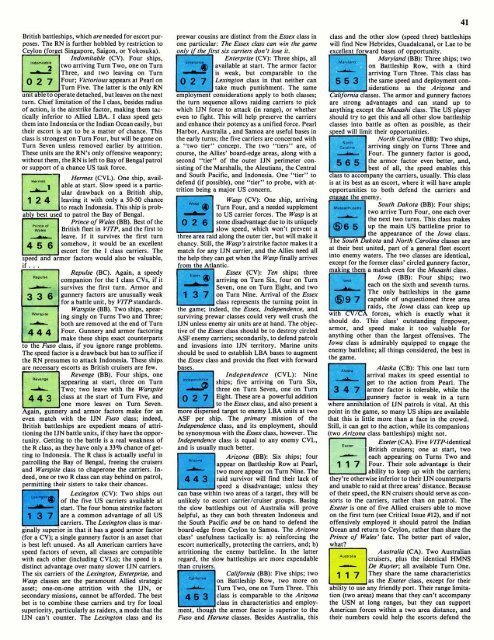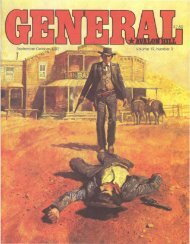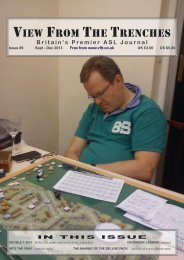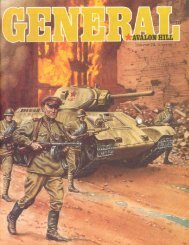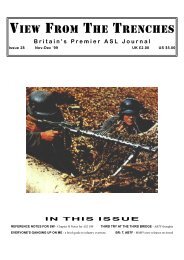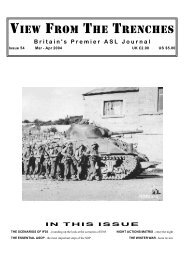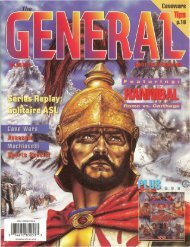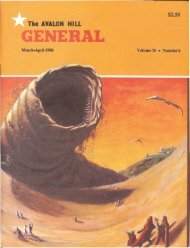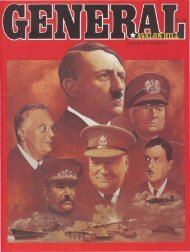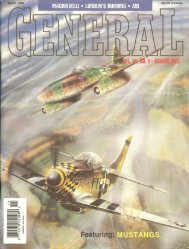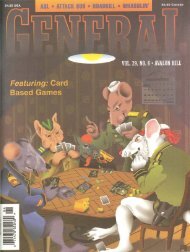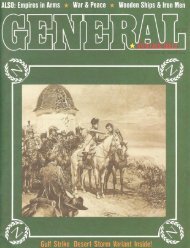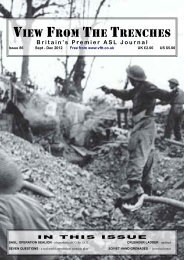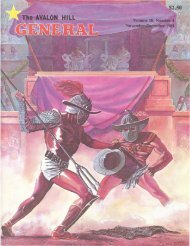18.64MB - View From The Trenches
18.64MB - View From The Trenches
18.64MB - View From The Trenches
- TAGS
- trenches
- www.vftt.co.uk
Create successful ePaper yourself
Turn your PDF publications into a flip-book with our unique Google optimized e-Paper software.
British battleships, which are needed for escort pur-<br />
poses. <strong>The</strong> RN is further hobbled by restriction to<br />
Ceylon (forget Singapore, Saigon, or Yokosuka).<br />
ble (CV). Four ships,<br />
Turn Two, one on Turn<br />
of action, is the airstrike factor, making them tac-<br />
tically inferior to Allied LBA. I class speed gets<br />
them into Indonesia or the Indian Ocean easily, but<br />
their escort is apt to be a matter of chance. This<br />
class is strongest on Turn Four, but will be gone on<br />
Turn Seven unless removed earlier by attrition.<br />
<strong>The</strong>se units are the RN's only offensive weaponry;<br />
without them, the RN is left to Bay of Bengal patrol<br />
or support of a chance US task force.<br />
if ...<br />
Repulse (BC). Again, a speedy<br />
companion for the I class CVs, if it<br />
survives the first turn. Armor and<br />
gunnery factors are unusually weak<br />
for a battle unit, by VITPstandards.<br />
Warspite (BB). Two ships, apearing<br />
singly on Turns Two and Three;<br />
both are removed at the end of Turn<br />
Four. Gunnery and armor factoring<br />
make these ships exact counterparts<br />
to the Fuso class, if you ignore range problems.<br />
<strong>The</strong> speed factor is a drawback but has to suffice if<br />
the RN presumes to attack Indonesia. <strong>The</strong>se ships<br />
are necessarv escorts as British cruisers are few.<br />
Revenge (BB). Four ships, one<br />
appearing at start, three on Turn<br />
Two; two leave with the Warspite<br />
class at the start of Turn Five, and<br />
one more leaves on Turn Seven.<br />
Again, gunnery and armor factors make for an<br />
even match with the IJN Fuso class; indeed,<br />
British battleships are expedient means of attritioning<br />
the IJN battle units, if they have the opportunity.<br />
Getting to the battle is a real weakness of<br />
the R class, as they have only a 33% chance of getting<br />
to Indonesia. <strong>The</strong> R class is actually useful in<br />
patrolling the Bay of Bengal, freeing the cruisers<br />
and Warspite class to chaperone the carriers. Indeed,<br />
one or two R class can stay behind on patrol,<br />
~ermitting their sisters to take their chances.<br />
Lexington (CV): Two ships out<br />
of the five US carriers available at<br />
start. <strong>The</strong> four bonus airstrike factors<br />
are a common advantage of all US<br />
I dcarriers. <strong>The</strong> Lexington class is marginally<br />
superior in that it has a good armor factor<br />
(for a CV); a single gunnery factor is an asset that<br />
is best left unused. As all American carriers have<br />
speed factors of seven, all classes are compatible<br />
with each other (including CVLs); the speed is a<br />
distinct advantage over many slower IJN carriers.<br />
<strong>The</strong> six carriers of the Lexington, Enterprise, and<br />
Wasp classes are the paramount Allied strategic<br />
asset; one-on-one attrition with the IJN, or<br />
secondary missions, cannot be afforded. <strong>The</strong> best<br />
bet is to combine these carriers and try for local<br />
superiority, particularly as raiders, a mode that the<br />
IJN can't counter. <strong>The</strong> Lexington class and its<br />
prewar cousins are distinct from the Essex class in<br />
one particular: <strong>The</strong> Essex class can win the game<br />
'v if the first six carriers don't lose it.<br />
I Enterprise (CV): Three ships, all<br />
available at start. <strong>The</strong> armor factor<br />
is weak, but comparable to the<br />
Lexington class in that neither can<br />
take much punishment. <strong>The</strong> same<br />
employr considerations apply to both classes;<br />
the turn sequence allows raiding carriers to pick<br />
which IJN force to attack (in range), or whether<br />
even to fight. This will help preserve the carriers<br />
and enhance their potency as a unified force. Pearl<br />
Harbor, Australia , and Samoa are useful bases in<br />
the early turns; the five carriers are concerned with<br />
a "two tier" concept. <strong>The</strong> two "tiers" are, of<br />
course, the Allies' board-edge areas, along with a<br />
second "tier" of the outer IJN perimeter con-<br />
sisting of the Marshalls, the Aleutians, the Central<br />
and South Pacific, and Indonesia. One "tier" to<br />
defend (if possible), one "tier" to probe, with at-<br />
trition being a major US concern.<br />
Wasp (CV): One ship, arriving<br />
Turn Four, and a needed supplement<br />
to US carrier forces. <strong>The</strong> Wasp is at<br />
some disadvantage due to its uniquely<br />
slow speed, which won't prevent a<br />
L~IIGG alca ~did along the outer tier, but will make it<br />
chancy. Still, the Wasp's airstrike factor makes it a<br />
match for any IJN carrier, and the Allies need all<br />
the help they can get when the Wasp finally arrives<br />
m the Atlantic.<br />
Essex (CV): Ten ships; three<br />
arriving on Turn Six, four on Turn<br />
Seven, one on Turn Eight, and two<br />
on Turn Nine. Arrival of the Essex<br />
I class represents the turning point in<br />
...- gan.-, .ndeed, the Essex, Independence, and<br />
surviving prewar classes could very well crush the<br />
IJN unless enemy air units are at hand. <strong>The</strong> objective<br />
of the Essex class should be to destroy circled<br />
ASF enemy carriers; secondarily, to defend patrols<br />
and invasions into IJN territory. Marine units<br />
should be used to establish LBA bases to augment<br />
the Essex class and provide the fleet with forward<br />
bases. -7 Independence (CVL): Nine<br />
ships; five arriving on Turn Six,<br />
three on Turn Seven, one on Turn<br />
Eight. <strong>The</strong>se are a powerful addition<br />
to the Essex class, and also present a<br />
more dispersed target to enemy LBA units at two<br />
ASF per ship. <strong>The</strong> primary mission of the<br />
Independence class, and its employment, should<br />
be synonymous with the Essex class, however. <strong>The</strong><br />
Independence class is equal to any enemy CVL,<br />
and is usually much better.<br />
Arizona (BB): Six ships; four<br />
7 appear on Battleship Row at Pearl,<br />
two more appear on Turn Nine. <strong>The</strong><br />
raid survivor will find their lack of<br />
speed a disadvantage; unless they<br />
I base wir iin two areas of a target, they will be<br />
unlikely to escort carrier/cruiser groups. Basing<br />
the slow battleships out of Australia will prove<br />
helpful, as they can both threaten Indonesia and<br />
the South Pacific and be on hand to defend the<br />
board-edge from Ceylon to Samoa. <strong>The</strong> Arizona<br />
class' usefulness tactically is: a) reinforcing the<br />
escort numerically, protecting the carriers, and; b)<br />
attritioning the enemy battleline. In the latter<br />
regard, the slow battleships are more expendable<br />
than cruisers.<br />
- California (BB): Five ships; two<br />
on Battleship Row, two more on<br />
Turn Two, one on Turn Three. This<br />
class is comparable to the Arizona<br />
class in characteristics and employ-<br />
ment, thougn the armor factor is superior to the<br />
Fuso and Haruna classes. Besides Australia, this<br />
class and the other slow (speed three) battleships<br />
will find New Hebrides, Guadalcanal, or Lae to be<br />
cellentforward<br />
1<br />
bases of opportunity.<br />
Maryland<br />
(BB): Three ships; two<br />
on Battleship Row, with a third<br />
arriving Turn Three. This class has<br />
the same speed and deployment con-<br />
= 'derations as the Arizona and<br />
rlvoi classes. <strong>The</strong> armor and gunnery factors<br />
are strong advantages and can stand up to<br />
anything except the Musashi class. <strong>The</strong> US player<br />
should try to get this and all other slow battleship<br />
classes into battle as often as possible, as their<br />
speed will limit their opportunities.<br />
North Carolina (BB): Two ships,<br />
.riving singly on Turns Three and<br />
Four. <strong>The</strong> gunnery factor is good,<br />
the armor factor even better, and,<br />
1 I best of all, the speed enables this<br />
class to accompany the carriers, usually. This class<br />
is at its best as an escort, where it will have ample<br />
opportunities to both defend the carriers and<br />
!-7<br />
en a e the enemy.<br />
South Dakota (BB): Four ships;<br />
two arrive Turn Four, one each over<br />
the next two turns. This class makes<br />
up the main US battleline prior to<br />
the appearance of the Iowa class.<br />
<strong>The</strong> South Dakota and North Carolina classes are<br />
at their best united, part of a general fleet escort<br />
into enemy waters. <strong>The</strong> two classes are identical,<br />
except for the former class' circled gunnery factor,<br />
making them a match even for the Musushi class.<br />
A<br />
Iowa (BB): Four ships; two<br />
-~ch on the sixth and seventh turns.<br />
<strong>The</strong> only battleships in the game<br />
capable of unquestioned three area<br />
raids, the Iowa class can keep up<br />
with forces, which is exactly what it<br />
should do. This class' outstanding firepower,<br />
armor, and speed make it too valuable for<br />
anything other than the largest offensives. <strong>The</strong><br />
Iowa class is admirably equipped to engage the<br />
enemy battleline; all things considered, the best in<br />
r51 - -*Innery<br />
Alaska (CB): This one last turn<br />
arrival makes its speed essential to<br />
get to the action from Pearl. <strong>The</strong><br />
armor factor is tolerable, while the<br />
factor is weak in a turn<br />
where annihilation of IJN patrols is vital. At this<br />
point in the game, so many US ships are available<br />
that this is little more than a face in the crowd.<br />
Still, it can get to the action, while its companions<br />
(two Arizona class battleships) might not.<br />
Exeter (CA). Five VITP-identical<br />
British cruisers; one at start, two<br />
each appearing on Turns Two and<br />
Four. <strong>The</strong>ir sole advantage is their<br />
ability to keep up with the carriers;<br />
they're otherwise inferior to their IJN counterparts<br />
and unable to raid at three areas' distance. Because<br />
of their speed, the RN cruisers should serve as con-<br />
sorts to the carriers, rather than on patrol. <strong>The</strong><br />
Exeter is one of five Allied cruisers able to move<br />
on the first turn (see Critical Issue #12), and if not<br />
offensively employed it should patrol the Indian<br />
Ocean and return to Ceylon, rather than share the<br />
Prince of Wales' fate. <strong>The</strong> better part of valor,<br />
Australia (CA). Two Australian<br />
cruisers, plus the identical HMNS<br />
De Ruyter; all available Turn One.<br />
<strong>The</strong>y share the same characteristics<br />
as the Exeter class, except for their<br />
ability to use any friendly port. <strong>The</strong>ir range limita-<br />
tion (two areas) means that they can't accompany<br />
the USN at long ranges, but they can support<br />
American forces within a two area distance, and<br />
their numbers could help the escorts defend the


